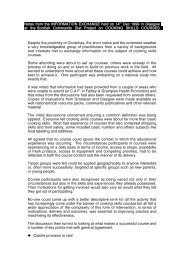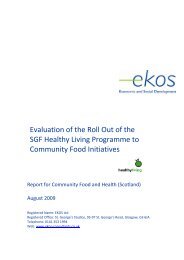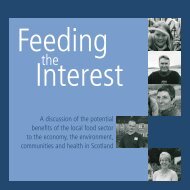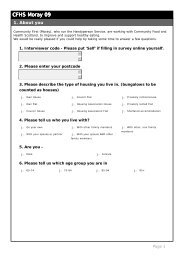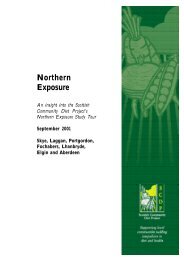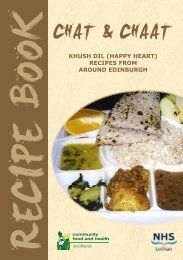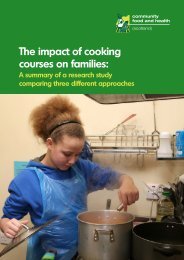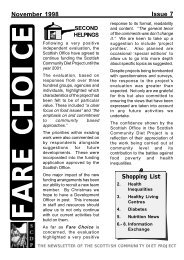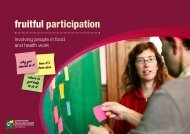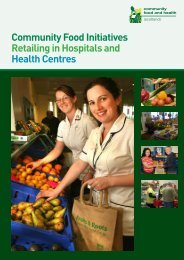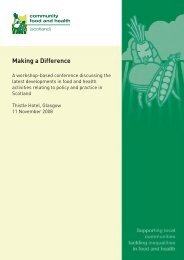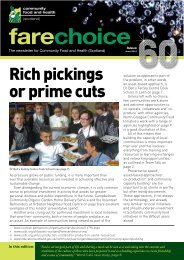North Glasgow Youth Food Guidelines and Healthy Eating Toolkit
North Glasgow Youth Food Guidelines and Healthy Eating Toolkit
North Glasgow Youth Food Guidelines and Healthy Eating Toolkit
You also want an ePaper? Increase the reach of your titles
YUMPU automatically turns print PDFs into web optimized ePapers that Google loves.
13 - 14 <strong>North</strong> <strong>Glasgow</strong> <strong>Youth</strong> <strong>Food</strong> <strong>Guidelines</strong> <strong>and</strong> <strong>Healthy</strong> <strong>Eating</strong> <strong>Toolkit</strong><br />
COOKERY CLASSES AND TASTER SESSIONS<br />
Cookery classes, demonstrations or taster sessions can be run in lots<br />
of different ways depending on your group, facilities, resources <strong>and</strong><br />
time. Taking part in practical food activities encourages young people<br />
to try new things <strong>and</strong> learn new skills. There are many useful resources<br />
for planning a cookery session, including:<br />
A Taste for Independence.<br />
Examples of cookery work with young people:<br />
www.communityfood<strong>and</strong>health.org.uk<br />
Get Shopping Get Cooking: resource developed<br />
by the coop: www.co-operative.co.uk<br />
Get Cooking! Resource pack from the <strong>Food</strong><br />
St<strong>and</strong>ards Agency: www.food.gov.uk<br />
Some ideas to get you started:<br />
Exotic Fruit Tasters<br />
Chop up a selection of ‘exotic’ fruits, e.g. papaya,<br />
mango, pineapple, sharon fruit, lychee, different types<br />
of melon, star fruit; whatever is available. Encourage<br />
the young people to try each <strong>and</strong> see if they can<br />
guess what they are.<br />
Blindfold Taste Test<br />
Young people are blindfolded <strong>and</strong> asked to<br />
taste various samples of foods <strong>and</strong> their ‘healthier’<br />
alternative (marked with a star). Ask the young people<br />
if they can guess what they are <strong>and</strong> which one they<br />
prefer, <strong>and</strong> lead a discussion on why some are a<br />
more healthy choice than others. Chop up small<br />
pieces of the following foods, or think up your<br />
own combinations:<br />
<strong>Food</strong> 1: a) sliced white bread<br />
b) sliced wholegrain bread *<br />
Ready Steady Cook!<br />
1. Split your group into 2 teams, <strong>and</strong> give each a<br />
bag of ingredients which are tailored towards a<br />
certain dish.<br />
2. Teams are also allowed to use ‘store cupboard’<br />
ingredients like oil, stock <strong>and</strong> spices.<br />
3. Teams can swap one item between them if they like.<br />
4. They are then given a set time to create a dish from<br />
their ingredients: 30-40 minutes.<br />
5. The youth worker or young people not involved<br />
then taste both dishes <strong>and</strong> decide which team wins.<br />
Hint: make sure the tutor <strong>and</strong> participants are aware<br />
of food safety <strong>and</strong> hygiene before the class starts.<br />
For information on food hygiene training see ‘useful<br />
contacts’ in this pack.<br />
FOOD LABELS: WHAT’S A LOT AND WHAT’S A LITTLE<br />
This exercise aims to get young people thinking about the salt, fat,<br />
sugar <strong>and</strong> calorie content of foods as well as learning how to read<br />
food labels. The <strong>Food</strong> St<strong>and</strong>ards Agency use traffic lights to show<br />
whether a food is particularly high or low in a certain nutrient.<br />
Refer to this table as young people work through<br />
the 6 comparisons. You could use the examples given<br />
here or use foods or snacks that the young people eat.<br />
Also use the eatwell plate alongside this exercise to<br />
explain why we might want to increase or decrease<br />
our intake of certain foods.<br />
• Put these foods in order from most to least salt<br />
per 100g (Hint: sodium x 2.5 = salt) (Babybel<br />
cheese, Tesco Multigrain Farmhouse Bread, Tesco<br />
dried pasta).<br />
Answer: the cheese has the highest amount of salt<br />
(1.7g), then bread (1g), <strong>and</strong> then pasta (trace) has<br />
the least. Traffic light info: the cheese is HIGH in<br />
salt, bread MEDIUM <strong>and</strong> pasta LOW.<br />
• Which cake/biscuit is highest in saturated fat per<br />
100g? (Nairn’s organic oat cakes, Tracker bar, Mr<br />
Kipling Bakewell Slice).<br />
Answer: the cereal bar is highest in saturated fat<br />
(11.1g); oatcakes are the lowest (4.4g). Traffic light<br />
info: the cereal bar <strong>and</strong> cake bar are both HIGH<br />
in saturated fat, <strong>and</strong> the oatcakes are MEDIUM.<br />
• Which yoghurt has the most sugar per 100g?<br />
(Onken Cherry Biopot, Muller cherry Fruit Corner,<br />
Yeo Valley strawberry Fruity Favourites).<br />
Answer: Onken has the most sugar (16.3g), then<br />
Muller (13g) <strong>and</strong> Yeo Valley has the least (11.5g).<br />
Traffic light info: Onken is HIGH in sugars, <strong>and</strong><br />
Muller <strong>and</strong> Yeo Valley are MEDIUM.<br />
• Put these foods in order from most to least<br />
calories per 100g (Ben & Jerry’s Half Baked Ice<br />
Cream, Eat Natural Lunchies bar, Pickled Onion<br />
Monster Munch).<br />
Answer: the crisps are highest in calories per 100g<br />
(490kcal), then the cereal bar (353kcal) <strong>and</strong> the icecream<br />
has the least (270kcal).<br />
• Which of these foods is highest in fibre per 100g?<br />
(Red lentils, Tesco braeburn apples, Princes tuna<br />
in spring water).<br />
Answer: The lentils have the most fibre (4.9g),<br />
followed by the apples (1.8g) <strong>and</strong> the tuna has<br />
least (nil).<br />
<strong>Food</strong> 2: a) semi-skimmed milk *<br />
b) full-fat milk<br />
<strong>Food</strong> 3: a) reduced fat crisps *<br />
b) regular crisps<br />
<strong>Food</strong> 4: a) cheddar cheese<br />
b) reduced fat cheddar cheese *<br />
Theme Nights<br />
Ask your group to choose a country, e.g. Italy, India,<br />
Scotl<strong>and</strong>, or France. With the group brainstorm the<br />
types of food we associate with this country, <strong>and</strong> if<br />
possible bring in some food tasters or hold a cookery<br />
demonstration to create a national dish.



